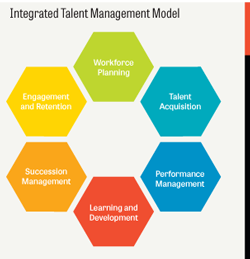TD Magazine Article
Examining Integrated Talent Management
Show value by learning to align initiatives, collecting data, and demonstrating the impact on business results.
Sun Sep 08 2013

Today, world-class organizations are expanding the role of talent management by creating integrated talent management (ITM) organizations. These organizations have professionals who are motivated to implement talent management initiatives designed to drive the achievement of business goals, and are taking bold steps to measure the impact of those initiatives.
ITM is focused on building business capability by aligning the various talent management functions so that ITM can have a stronger impact on business results—the whole becomes greater than the individual parts. Alignment can lead to stronger business results, increase efficiency and effectiveness, and create higher performing individuals and organizations.
But what is meant by the term "integrated talent management"? In our book, Integrated Talent Management Scorecards: Insights From World-Class Organizations on Demonstrating Value (ASTD Press), ITM is defined as "united functions with a common goal to attain employee capabilities that will increase business performance."
Integrated talent management model
ITM functions often are referred to using different terminology. The model illustrated below incorporates six talent management functions that are its core components.

Workforce planning refers to the strategic process of forecasting the talent needs of the business and creating plans that will ensure high performance. Strategic workforce planning includes assessing the business direction, determining talent implications, identifying segmented roles, and defining the build or buy actions to be taken. The output of strategic workforce planning assessments will influence the goals of the other talent management functions.
Talent acquisition involves attracting, selecting, and acquiring the right talent that the business needs to accomplish its strategy and goals. The talent needs to be acquired at the right time, in the right place, and for the right price.
Performance management includes how the business and individuals set goals, and manage and measure the performance required to achieve strong individual and business performance. The business goals cascade downward to achieve performance alignment.
Learning and development places emphasis on the professional development required by individuals to successfully do their jobs such as technical or job-related skills training and related competencies. It also includes career development for individuals and leadership development for all levels of managers, as well as onboarding and mentoring.
Succession management is focused on how businesses effectively identify, develop, and transition individuals into key roles to ensure continued business success. It includes not only replacement planning, but also the identification and development of high-potential individuals and the management of talent pools. Leadership competencies, executive development, 360-degree feedback, executive coaching, and job rotations also are within this talent management function.
Engagement and retention is focused on such talent management efforts as employee engagement or satisfaction surveys and related action planning. It also includes a focus on the tools and programs that can be implemented to reward and motivate individuals such as incentive programs, diversity initiatives, employee resource groups, and recognition programs.
Scorecards
Even when talent management functions are integrated and aligned with strategic priorities, they often aren't able to easily demonstrate their contributions to business results. And yet, the purpose of integrating these functions is to have a significant impact on the business and achieve important business results.
For an ITM organization to be successful, it needs to be able to show that it has achieved results that have contributed to the success of the business. The implementation of ITM scorecards can enable such organizations to align talent management initiatives with business goals, collect and analyze data, and report the impact of these initiatives on business results. There are three levels of scorecards: TM organizational macro scorecards, TM functional macro scorecards, and TM initiative micro scorecards.
The TM organizational macro scorecard is created at the ITM organization level and is directly aligned with business-level goals and measures such as revenue, operational costs, customer satisfaction, product or service quality, employee engagement, and turnover. It contains a roll-up of the metrics for all talent management functions within the organization, which shows the overall ITM contribution to each business goal.
The TM functional macro scorecard is created at the talent management functional level. The functions may include talent acquisition, learning and development, and succession management. This scorecard is aligned with the TM organizational macro scorecard, but would include additional activity, efficiency, and effectiveness measures specific to the talent management function that would roll up measures from the TM initiative micro scorecards.
Finally, TM initiative micro scorecards are aligned with the TM functional macro scorecard measures and may include additional activity, efficiency, and effectiveness measures for the initiative. Each talent management initiative has its own micro scorecard with such metrics as reaction, learning, application, business impact, and return-on-investment data.
TM initiative micro scorecards
The TM initiative micro scorecard provides detailed data that describe the success of each program. This scorecard can provide, in a single table, all the data resulting from an impact study of a talent management initiative. The TM macro and micro scorecards use the same evaluation framework defined by Donald Kirkpatrick and Jack Phillips.
In the TM initiative micro scorecard, the section under the satisfaction heading would include the results of a Level 1 analysis that indicate the extent to which the participants were satisfied with the initiative. Examples of what to include in the results section would be
relevance of the talent management initiative to the job
recommendation of the initiative to others
importance of the information received
intention to use the initiative's offerings
an overall rating from a satisfaction questionnaire or other measure.
The section under the learning heading would include the extent to which the learning objectives have been met based on results of a Level 2 analysis. Examples of what to include in the results section would be
the participants' assessments of the initiative
scores from any learning measurement that may have been conducted such as a test or other assessment
observations from others.
The application section would include the extent to which the performance objectives were met. Listed would be the results of a Level 3 analysis, including:
the importance of the use of the initiative in the work environment
the level of initiative adoption
performance (actual or anticipated) change or improvements.
The tangible benefits section would include the extent to which the impact objectives have been met. These would be impact data (Level 4 analysis) and possibly ROI data (Level 5 analysis). Examples of what to include under the results section would include improvements in:
productivity or efficiency
quality
cost control
customer satisfaction.
The section under the intangible benefits heading would include those benefits discovered in the Level 4 analysis that could not be converted into a tangible monetary value, but are seen by the organization as providing value. For example:
improved customer satisfaction
increased job satisfaction
reduced conflicts
reduced stress
increased teamwork.
If performance and business impact are measured, the method used to isolate the impact of the talent management initiative would be provided such as a control group arrangement or participant or executive perceptions. If an ROI or benefit-cost-ratio analysis is conducted, the technique used to convert the impact data would be listed, as would the fully loaded program costs. Also listed would be barriers that impeded the success of the initiative, and recommendations that were made as a result of evaluating the talent management initiative.
The TM initiative micro scorecard format may vary by program or may have some elements missing because all levels of evaluation for that initiative were not conducted. No matter the format used or the levels of evaluation conducted, there are critical success factors that should be considered when implementing both macro and micro level scorecards.
An ITM organization has the ability to create stronger alignment with the business and demonstrate its value by creating TM macro- and micro-level scorecards. The scorecards show that the talent management team is aligned with the goals of the business and is helping to achieve those goals.
Examples of Talent Management Initiatives
Each talent management initiative has its own micro scorecard with metrics, including reaction, learning, application, business impact, and return-on-investment data. Here are sample initiatives aligned to the six functions of the talent management model.
Workforce planning: identification of strategic, key, core, and transitional roles and implementation of the action plans associated with each role.
Talent acquisition: executive recruiting, recruiting for specific strategic or key roles, internships, and college recruiting.
Performance management: annual performance review process, quarterly performance review process, individual development plans, and performance improvement plans.
Learning and development: onboarding program, sales training, mentoring programs, career development initiatives, and management development.
Succession management: succession plans, 360-degree feedback, executive coaching, high-potential development program, and job rotations.
Engagement and retention: employee engagement survey, employee resource groups, recognition program, and a diversity initiative.
Critical Success Factors to Consider
When implementing talent management scorecards, it’s important to take the following steps.
Start building your scorecards today. Don’t wait for someone to request it because she might request the data in a different format that would not be nearly as meaningful or concise.
Begin with the end in mind. Plan in advance so your evaluation can aim at completing the scorecards successfully and comprehensively.
Always account for the influence of other factors.
Be conservative when converting and isolating. Consult additional resources as needed to do this credibly.
Involve management in the process.
Educate the talent management development and evaluation teams.
Be prepared to educate the stakeholders on the elements of the scorecards.
Use the scorecards to communicate the value of the integrated talent management functions and initiatives, and to reinforce the fact that your team is accountable for talent management results.
You've Reached ATD Member-only Content
Become an ATD member to continue
Already a member?Sign In
